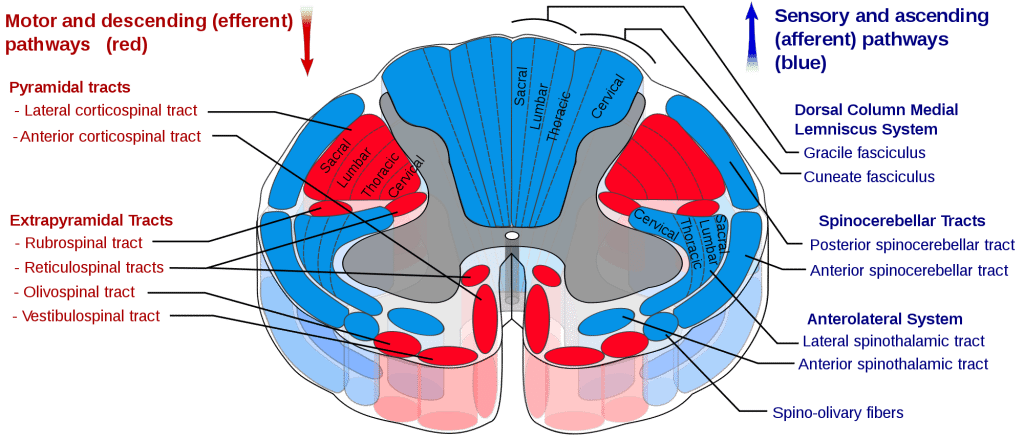I think it’s time to make a jump, and to look at the nervous networked that feeds the brain information about what’s going on with the body. There are two types of information relays.
There are pathways that transmit information that goes from the brain to the limbs (called descending tracks), and there are pathways that transmit the information from the limbs to the brain (called the ascending tracks).
But how do you know which track does what?

Let’s begin with the Spinothalamic Tract
First, look at the terminology: Spinothalamic. This gives you a hint as to the direction of the electrical signal. Spino-Thalamic. The information will travel from the spine up to the thalamus (which is situated in the brain). So yes, the spinothalamic tract is an ascending pathway.
At this point you already know that this pathway will have something to do with information about the body.
The spinothalamic tract is involved with perceptions of temperature, itch, touch, and pain.
We also said that the information is being relayed. The term relay applies really well to this situation because the electrical signal will be “relayed” from neuron to neuron as it ascends up to the thalamus.
Like most ascending pathways, there are 3 neuronal levels in the spinothalamic tract.
Spinothalamic Tract – Level 1
The level 1 neurons are called “primary neurons.” These primary neurons have free nerve endings that will translate pain, temperature, itch, or touch sensations into an electrical signal. These primary neurons can be pretty long and travel all the way from the bottom of the foot to the spinal cord.
The cell bodies of these primary neurons are located in dorsal root ganglions.Their axons enter the spinal cord through Lissauer’s fascicles, then go up one segment before synapsing. They will synapse in the posterior horn on the same side (ipsilateral side).
Spinothalamic Tract – Level 2
The secondary neurons begin in the posterior horn of the spinal cord (The primary neurons that we just talked about synapse on them).
At this point, there are two options for these neurons.
- They can travel up on the same side (ipsilateral ascension)
- Decussate and travel up on the opposite side (contralateral ascension). Most axons will mostly travel up on the contralateral side, but all will synapse in the thalamus (ipsilaterally or contralaterally).
The Contralateral Ascension
Decussation: the level 2 neurons send their axons across the midline before going up through the lateral spinothalamic tract. They will then synapse on the ventral post lateral nucleus of the thalamus.
It is interesting to note that axons from the lower limbs align themselves on the “lateral side” of the spinothalamic tract, whereas axons from the upper limbs align themselves more on the “central” side of the spinothalamic tract.
Along the way, some of these neurons branch out to the periaqueductal gray or to the reticular formation.
That’s pretty cool because pain can be down regulated at these levels. Which means that even if the body sends out a strong pain signal, the brain can actually modulate how much of that pain it will feel…..
Spinothalamic Tract – Level 3
The last level! The tertiary neurons begin in the ventral posterolateral nucleus of the thalamus. Their axons will travel through the internal capsule. They will keep on going through the corona radiate (I love that name). Their journey will end on the secondary sensory cortex.
Remember This:
- The Lateral Spinothalamic tract take pain and temperature info from the body to the brain (ascending).
- This relay system involves 3 neuronal levels.

my son has itched for 15 years, he is 31 , as I understand it, for the same reason he has asthma/allergy, I am considering accupuncture for him, is this as safe as accupressure or as good. we !, we need help
Sorry to hear about your son but we don’t provide medical advice here.
All the best!
Very easy to work with and gave a answer that was well thought out so that normal people hav a chance of understanding
Thanks so much for a simplified explanation of a very complex difficult to understand process. I can’t write anything intelligent on my case study until I can understand it, so thank you again. From Brenda